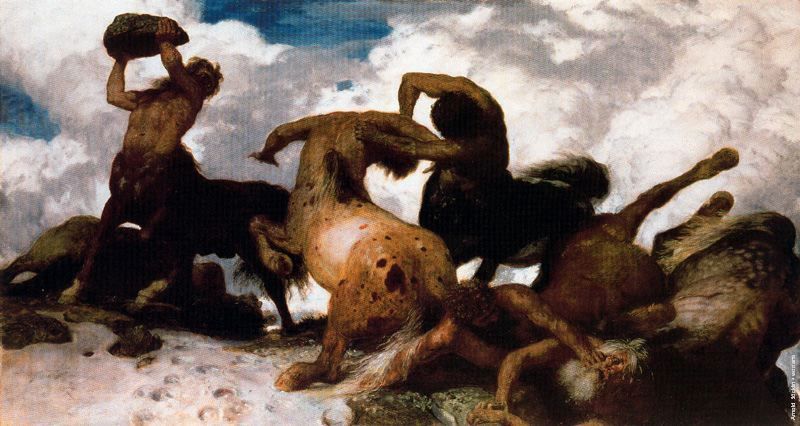Arnold Böcklin (16 October 1827 – 16 January 1901) was a symbolist Swiss painter. The painter rejected the naturalistic trends of his time and created symbolic, mythological works. Arnold Böcklin was born on Oct. 16, 1827, in Basel.
He was born in Basel. His father, Christian Frederick Böcklin (b. 1802), was descended from an old family of Schaffhausen, and engaged in the silk trade. His mother, Ursula Lippe, was a native of the same city. Arnold studied at the Düsseldorf academy (1845-1847) under Schirmer, and became a friend of Anselm Feuerbach. He is associated with the Düsseldorf school of painting. Schirmer, who recognized in him a student of exceptional promise, sent him to Antwerp and Brussels, where he copied the works of Flemish and Dutch masters. Böcklin then went to Paris, worked at the Louvre, and painted several landscapes.

After serving his time in the army, Böcklin set out for Rome in March 1850. The many sights of Rome were a fresh stimulus to his mind. These new influences brought allegorical and mythological figures into his compositions. In 1856 he returned to Munich, and remained there for four years.
His first fiancé died young. A second woman declined to marry. In Rome, he married Angela Rosa Lorenza Pascucci in 1853. The couple had fourteen children, but five died in childhood and another three died before Böcklin. He himself nearly succumbed to typhoid in 1859.
He then exhibited the Great Park, one of his earliest works, in which he treated ancient mythology. Of this period are his Nymph and Satyr, Heroic Landscape (Diana Hunting), both of 1858, and Sappho (1859). These works, which were much discussed, together with Lenbach’s recommendation, gained him appointment as professor at the Weimar academy. He held the office for two years, painting the Venus and Love, a Portrait of Lenbach, and a Saint Catherine.
He returned to Rome from 1862 to 1866, and there gave his fancy and his taste for violent colour free play in his Portrait of Mme Böcklin, and in An Anchorite in the Wilderness (1863), a Roman Tavern, and Villa on the Seashore (1864). He returned to Basel in 1866 to finish his frescoes in the gallery, and to paint, besides several portraits, The Magdalene with Christ (1868), Anacreon’s Muse (1869), and A Castle and Warriors (1871). His Portrait of Myself, with Death playing a violin (1872), was painted after his return again to Munich, where he exhibited Battle of the Centaurs, Landscape with Moorish Horsemen and A Farm (1875). From 1876 to 1885 Böcklin was working at Florence, and painted a Pietà, Ulysses and Calypso, Prometheus, and the Sacred Grove.
From 1886 to 1892 he settled at Zürich, after which he resided at San Domenico, near Florence. From this period are the Naiads at Play, A Sea Idyll, and War.
Böcklin died on 16 January 1901 in Fiesole. He is buried in the Cimitero degli Allori in the southern suburb of Florence, Italy.
Source: Wikipedia
He painted scenes of the Swiss Alps, using light effects and dramatic views subjectively to project emotional moods into the landscape.
In Arnold Böcklin’s Sanctuary of Hercules, three soldiers kneel reverently on the outer step of a shrine, while a fourth looks defiantly off into the distance. The sky, a rich panoply of gray, blue, and white, signals an approaching storm, and a strong wind whips through the trees, scattering the leaves and ruffling the plumes on the soldiers’ helmets. At the painting’s focal point is the sanctuary itself constructed of stones which are trimmed with polished marble and rest upon an equally smooth circular base. Within the enclosure is a sacred grove of massive trees and at the back, seen in darkened profile, a statue of Hercules, mythical hero and protector from danger.
At first glance, the subject appears very realistic and the shrine archaeologically accurate. Yet the scene also conveys a definite mood of mystery. The stones’ pure and richly harmonious colors glow with an unnatural radiance. The gloom inside the grove is equaled by the dark ominous clouds, lit by flashes of lightning on the horizon. Indebted to the romantics of the first half of the nineteenth century, Böcklin rejected the idea of painting solely from nature, and strove to express his own feelings through nature, with the use of vibrant coloration and dramatic.


